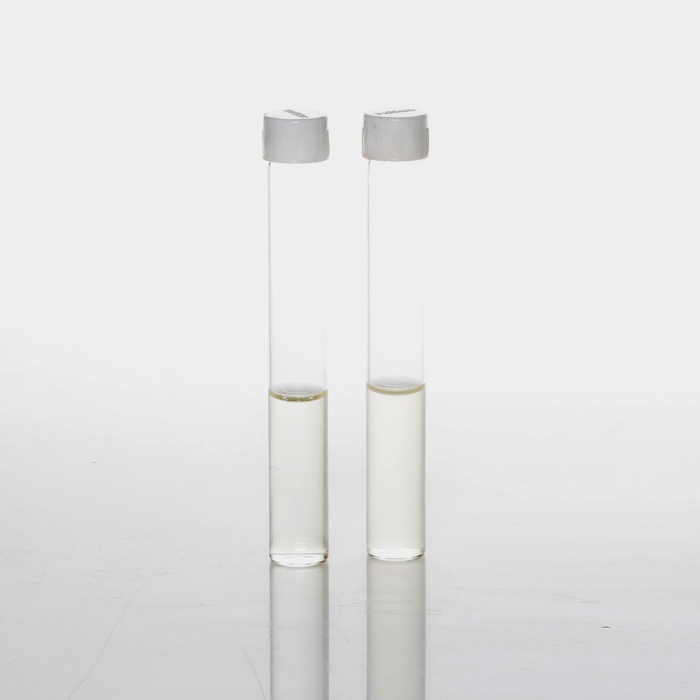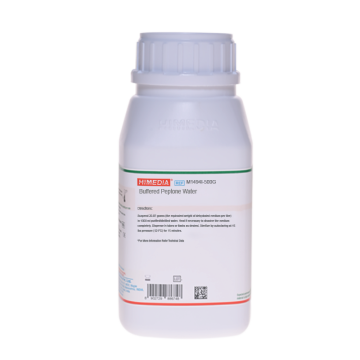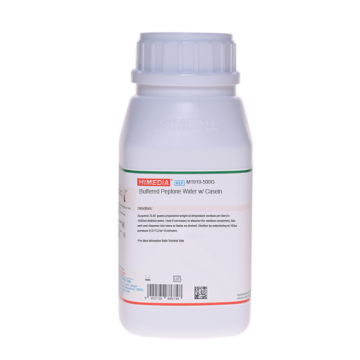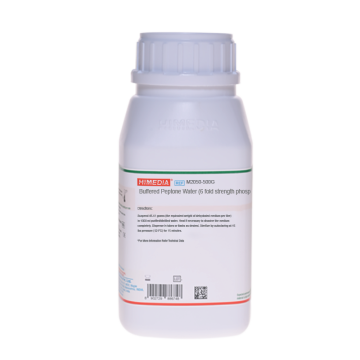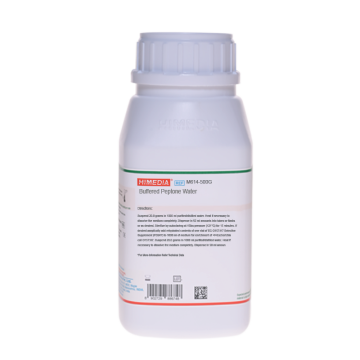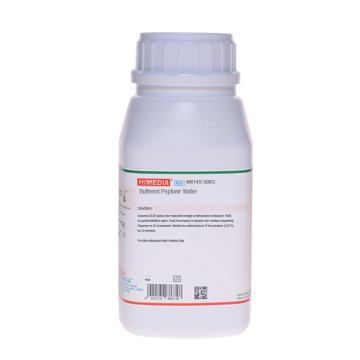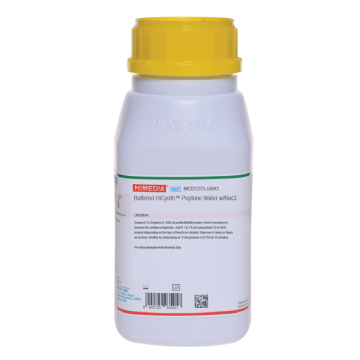 Your enquiry has been submitted
Your enquiry has been submitted
Buffered Peptone Water w/ NaCl
Intended use
Recommended as a diluent for carrying out microbial limit test from various specimens.
Composition**
| Ingredients | g/L |
|---|---|
| Peptone | 1.000 |
| Potassium dihydrogen phosphate | 3.560 |
| Disodium hydrogen phosphate | 7.230 |
| Sodium chloride | 4.300 |
Final pH (at 25°C): 7.0±0.2
**Formula adjusted, standardized to suit performance parameters
Directions
Suspend 16.09 grams in 1000 ml purified/distilled water. Heat if necessary to dissolve the medium completely. Add 0.1 to 1% w/v polysorbate 20 or 80 if desired(depending on the type of food to be diluted). Dispense in tubes or flasks as desired. Sterilize by autoclaving at 15 lbs pressure (121°C) for 15 minutes.
Principle And Interpretation
Buffered Peptone Water is a pre-enrichment medium designed to help recovery of sub-lethally damaged Salmonellae before transfer to a selective medium. This pre-enrichment medium is free from inhibitors and is well buffered and provides conditions for resuscitation of the cells that have been injured by processes of food preservation. It was noted by Edel and Kampelmacher (1) that sub-lethal injury to Salmonella may occur due to food preservation techniques involving heat, desiccation, high osmotic pressure, preservatives or pH changes. Buffered Peptone Water during the pre-enrichment period helps in recovery of injured cells that may be sensitive to low pH (2). This is particularly important for vegetable specimens, which have low buffering capacity. These media can be used for testing dry poultry feed (3). In a survey involving isolation of Salmonellae from meat that had been artificially contaminated with sub-lethally injured organisms. Pre-enrichment in Buffered Peptone Water w/NaCl at 37°C for 18 hours before selection in Tetrathionate Brilliant Green Bile Broth (M1255) showed superior results compared with direct selection method.
Lactose Broth is frequently used as a pre-enrichment medium but it may be detrimental to recovery of Salmonellae (4). Depending on the amount of fat in the sample to examine the kind and quantity of emulsifying agent to be used. These pre-enrichment media contain peptone as a source of carbon, nitrogen, vitamins and minerals. Sodium chloride maintains the osmotic balance and phosphates buffer the medium. The broth is rich in nutrients and produces high resuscitation rates for sub-lethally injured bacteria and supports intense growth. The phosphate buffer system prevents bacterial damage due to changes in the pH of the medium. Inoculate 10 grams specimen in 50 ml of these media and incubate at 35-37°C for 18 hours. Transfer 10 ml from this medium to 100 ml of Tetrathionate Broth (M032) and incubate at 43°C for 24-48 hours and then subculture on selective plating media. Examine the plates for characteristic Salmonella colonies.
Type of specimen
Food and dairy samples
Specimen Collection and Handling:
For food and dairy samples, follow appropriate techniques for sample collection and processing as per guidelines (5-7). After use, contaminated materials must be sterilized by autoclaving before discarding.
Warning and Precautions
Read the label before opening the container. Wear protective gloves/protective clothing/eye protection / face protection. Follow good microbiological lab practices while handling specimens and culture. Standard precautions as per established guidelines should be followed while handling specimens. Safety guidelines may be referred in individual safety data sheets.
Limitations :
- This medium contains low nutrients and hence is not recommended for the growth of organisms.
Performance and Evaluation
Performance of the medium is expected when used as per the direction on the label within the expiry period when stored at recommended temperature.
Quality Control
Appearance White to cream homogeneous free flowing powder
Colour and Clarity of prepared medium Colourless to pale yellow clear solution without any precipitate
Reaction Reaction of 1.60% w/v aqueous solution at 25°C. pH: 7.0±0.2
pH 6.80-7.20
Cultural response
Cultural characteristics observed after recovery on Soybean Casein Digest Agar after an incubation at 30-35°C for 18-24 hours for bacteria and Sabouraud Dextrose Agar at 30-35°C for 24-48 hours.
| Organism | Inoculum (CFU) | Recovery within 2 hours of incubation | Recovery within 4 hours of incubation | Recovery within 24 hours of incubation |
|---|---|---|---|---|
| Escherichia coli ATCC 8739 (00012*) | 50-100 | no decrease in colony count | no decrease in colony count | no decrease in colony count (stored at 2-8°C) |
| Escherichia coli ATCC 25922 (00013*) | 50-100 | no decrease in colony count | no decrease in colony count | no decrease in colony count (stored at 2-8°C) |
| Staphylococcus aureus subsp. aureus ATCC 6538 (00032*) | 50-100 | no decrease in colony count | no decrease in colony count | no decrease in colony count (stored at 2-8°C) |
| Staphylococcus aureus subsp. aureus ATCC 25923 (00034*) | 50-100 | no decrease in colony count | no decrease in colony count | no decrease in colony count (stored at 2-8°C) |
| ^Pseudomonas paraeruginosa ATCC 9027 (00026*) | 50-100 | no decrease in colony count | no decrease in colony count | no decrease in colony count (stored at 2-8°C) |
| Pseudomonas aeruginosa ATCC 27853 (00025*) | 50-100 | no decrease in colony count | no decrease in colony count | no decrease in colony count (stored at 2-8°C) |
| Salmonella Typhimurium ATCC 14028 (00031*) | 50-100 | no decrease in colony count | no decrease in colony count | no decrease in colony count (stored at 2-8°C) |
| Salmonella Abony NCTC 6017 (00029*) | 50-100 | no decrease in colony count | no decrease in colony count | no decrease in colony count (stored at 2-8°C) |
| $ Kokuria rhizophila ATCC 9341 | 50-100 | no decrease in colony count | no decrease in colony count | no decrease in colony count (stored at 2-8°C) |
| ** Bacillus spizizenii ATCC 6633 (00003*) | 50-100 | no decrease in colony count | no decrease in colony count | no decrease in colony count (stored at 2-8°C) |
| Candida albicans ATCC 10231 (00054*) | 50-100 | no decrease in colony count | no decrease in colony count | no decrease in colony count (stored at 2-8°C) |
| Candida albicans ATCC 2091 (00055*) | 50-100 | no decrease in colony count | no decrease in colony count | no decrease in colony count (stored at 2-8°C) |
Key:
* - Corresponding WDCM Numbers
^ Formerly known as Pseudomonas aeruginosa
$ -Formerly known as Micrococcus luteus
**Formerly known as Bacillus subtilis subsp. spizizenii
Storage and Shelf Life
Store between 10-30°C in a tightly closed container and the prepared medium at 15-30°C. Use before expiry date on the label. On opening, product should be properly stored dry, after tightly capping the bottle inorder to prevent lump formation due to the hygroscopic nature of the product. Improper storage of the product may lead to lump formation. Store in dry ventilated area protected from extremes of temperature and sources of ignition Seal the container tightly after use. Product performance is best if used within stated expiry period.
Disposal
User must ensure safe disposal by autoclaving and/or incineration of used or unusable preparations of this product. Follow established laboratory procedures in disposing of infectious materials and material that comes into contact with sample must be decontaminated and disposed of in accordance with current laboratory techniques (8,9).
Reference
- Edel and Kampelmacher, 1973, Bull. W.H.O., 48:167.
- Sadovski, 1977, J. Food Technol., 12:85.
- Angelotti, 1963, Academic Press, New York, N.Y.
- Juven, Cox, Bailey, Thomson, Charles and Schutze, 1984, J. Food Prot., 47:299.
- Salfinger Y., and Tortorello M.L. Fifth (Ed.), 2015, Compendium of Methods for the Microbiological Examination of Foods, 5th Ed., American Public Health Association, Washington, D.C.
- Wehr H. M. and Frank J. H., 2004, Standard Methods for the Microbiological Examination of Dairy Products, 17th Ed., APHA Inc., Washington, D.C.
- American Public Health Association, Standard Methods for the Examination of Dairy Products, 1978, 14th Ed., Washington D.C.
- Isenberg, H.D. Clinical Microbiology Procedures Handbook 2nd Edition.
- Jorgensen, J.H., Pfaller, M.A., Carroll, K.C., Funke, G., Landry, M.L., Richter, S.S and Warnock., D.W.(2015) Manual of Clinical Microbiology, 11th Edition. Vol. 1.
| Product Name | Buffered Peptone Water w/ NaCl |
|---|---|
| SKU | M1275 |
| Product Type | Regular |
| Physical Form | Powder |
| Origin | Animal |
| Packaging type | HDPE |
| References | 1. Edel and Kampelmacher, 1973, Bull. W.H.O., 48:167. |
| Customized Product Available | No |







